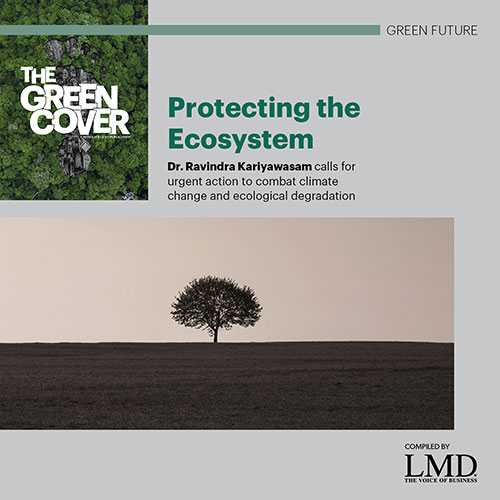CORPORATE ACCOUNTABILITY
Blueprint for Accountability
Prof. Roshanka Ranasinghe says that corporate liability must evolve from ambition to measurable impact
In today’s climate conscious era, corporate accountability is no longer optional – it is an essential part of responsible business leadership. As the climate crisis intensifies, the expectations placed on companies to act decisively and transparently are rising. With their scale, influence and access to resources, businesses are uniquely positioned to drive meaningful change.
But beyond ambition, what does genuine accountability entail? How can businesses align profitability with environmental stewardship?
Prof. Roshanka Ranasinghe explores these pressing questions, and outlines a roadmap for responsible corporate climate action and challenges, strategies and innovations that will help shape the path forward.
DEFINING ACCOUNTABILITY Corporate accountability, in the context of climate change, refers to an organisation’s obligation to measure, disclose, reduce and take responsibility for its greenhouse gas emissions and climate-related risks – while aligning its strategies, operations and influence with climate science, ethical standards and the Paris Agreement’s goal of limiting warming to 1.5°C above preindustrial levels.
Ranasinghe explains that it begins with transparent measurement and reporting, where organisations track and publicly disclose their greenhouse gas emissions using established frameworks such as the Task Force on Climate-related Financial Disclosures (TCFD) and the Greenhouse Gas Protocol.
He says: “Setting science-based targets is equally crucial – emissions reduction goals must align with the Intergovernmental Panel on Climate Change (IPCC) pathways and be validated by initiatives such as the Science Based Targets initiative (SBTi). Risk management and governance structures must also integrate climate risks into enterprise systems, with accountability upheld at the board and executive levels.”
Operational responsibility, he adds, extends across the supply chain, and requires companies to reduce internal emissions and work closely with suppliers to decarbonise the entire value chain.
Ensuring social and environmental justice is also key while supporting a just transition that considers the needs of workers and vulnerable communities. He underscores the importance of ethical influence – corporate lobbying, advocacy and communications, that reflects and supports genuine climate goals.
CORPORATE INFLUENCE Ranasinghe believes that corporations must play a transformational and accountable role in climate action, and that their impact extends across global emissions, supply chains and consumption patterns. As such, companies must embed climate responsibility at the heart of their business strategy, governance and operations.
“Beyond their own emissions, businesses must act as enablers of a low carbon economy. This includes investing in sustainable innovation, influencing consumer behaviour and advocating for environmental policy reform. Equally important is their responsibility to support a just transition – ensuring that the shift to sustainable practices benefits communities, safeguards jobs and promotes equity,” he stresses.
Ranasinghe says that by aligning with science-based targets and incorporating environmental, social and corporate governance (ESG) factors into decision making, corporations can mitigate risks, unlock market opportunities and build resilience while reinforcing trust with stakeholders.
CLIMATE INITIATIVES To ensure meaningful climate action, companies must establish robust metrics. He explains: “Measuring the effectiveness of climate-related initiatives requires a comprehensive set of metrics that reflect both environmental impact and progress towards broader sustainability goals. Key indicators include tracking greenhouse gas emissions – both in absolute terms and relative to business metrics such as revenue or output on a year on year basis.”
Ranasinghe notes that organisations must also assess their progress towards climate targets including interim milestones, and obtain third party verification of their commitments. The transition to renewable energy, he stresses, is another critical area, which requires close monitoring of clean power adoption.
Circularity and resource efficiency are equally important with metrics such as waste diversion rates and material reuse serving as key benchmarks. In the supply chain, he points out that decarbonisation efforts should be evaluated through supplier compliance and emissions data.
Ranasinghe further highlights the importance of climate risk integration that’s guided by frameworks such as the TCFD, to ensure that both physical and transitional risks are factored into corporate planning. Transparency and ESG reporting are essential for accountability, and supporting consistent, accurate and accessible disclosure.
“Investment in innovation and sector leadership is gauged by support for climate technology and influence on industry standards. Finally, alignment with policy goals is crucial, requiring consistency between corporate lobbying efforts and climate commitments, as well as active participation in credible coalitions,” he asserts.
ENVIRONMENTAL CHALLENGES Aligning business operations with environmental goals is a complex and multifaceted endeavour, often hindered by a range of significant challenges. Ranasinghe notes that among the most pressing challenges is short-term financial pressure, where the pursuit of immediate profits can lead to the deprioritisation of long-term sustainability initiatives.
He explains that complex global supply chains also pose difficulties, as indirect emissions – particularly from suppliers – are harder to monitor and manage. The high costs associated with transitioning to greener technologies and processes can be especially burdensome for SMEs and industries with legacy systems.
“Regulatory uncertainty adds another layer of complexity with inconsistent policies across regions making it difficult for companies to plan effectively. There’s also the risk of greenwashing where overstated or misleading claims about environmental performance can severely damage corporate credibility,” he cautions.
Internally, organisational resistance often rooted in entrenched structures or cultural inertia, can slowdown or obstruct sustainability efforts. Technological gaps remain a hurdle in some sectors, where viable low carbon alternatives are either unavailable or not yet scalable.
“The lack of reliable and consistent sustainability data continues to obstruct effective decision making and progress tracking. Overcoming these barriers calls for strong leadership, a commitment to innovation and a systems thinking approach that integrates sustainability across all levels of the organisation,” Ranasinghe avers.
SUSTAINABILITY INNOVATION He stresses that corporate investment in sustainability must be strategic, long term and deeply integrated into the core business model.
Ranasinghe identifies key focus areas including clean energy and electrification, smart infrastructure and the use of IoT to enhance efficiency, and the adoption of circular economy models. He also highlights the importance of sustainable agriculture, ethical sourcing and active collaborations with startups, academic institutions and industry coalitions to drive innovation.
Citing IKEA as a prime example, he notes that the company’s significant investments in renewable energy and sustainable design have not only reduced its environmental footprint but also lowered operational costs and boosted customer loyalty. “When approached holistically, innovation and sustainability can generate shared value across the triple bottom line – benefitting people, planet and profit,” he affirms.
RIGOROUS OVERSIGHT Corporate accountability won’t truly advance without systemic changes that reshape incentives, regulations, financial systems and cultural norms. However, Ranasinghe cautions that corporate action alone will not drive the transformation needed.
Among these, he lists the introduction of mandatory climate disclosure standards, carbon pricing and environmental taxation, and the establishment of sustainable corporate governance structures. He further calls for the alignment of financial systems with climate objectives through climate aligned investment, and stronger public policy and procurement frameworks that reward responsible practices.
He notes: “Global regulatory coordination is also vital as is the need for widespread education and cultural shifts in business leadership.” According to him, true progress hinges on reshaping the underlying systems that govern business conduct by rewarding sustainable behaviour and penalising inaction to ensure a future where environmental and economic goals are not only compatible but mutually reinforcing.
– Compiled by Tamara Rebeira
Prof. Roshanka Ranasinghe
Professor of Climate Change Impacts & Coastal Risk
IHE Delft Institute for Water Education
Delft, The Netherlands












